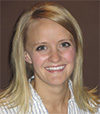Growing up on the small, 40-cow registered Holstein farm that my parents still operate in rural southwestern Wisconsin, I never imagined where future travels might take me.
I had always hoped my Spanish-speaking skills would come in handy in a dairy industry career – interacting with farm employees here in the U.S. or through work trips south of the border. Instead, my role at Alta Genetics has taken me beyond the U.S. – outside my comfort zone – to some of the most progressive dairies in Europe.
I’m fortunate to have gained insight from leading dairy producers and industry counterparts in the Netherlands, U.K., Italy and Germany – and I’ve had the bonus of adding a few stamps in my passport in the process.
As I prepared for each of these trips, my focus tended toward dairy genetics and reproduction. Yet I was curious to learn the larger concepts that separate U.S. and European dairy farms. What were the different mindsets, methods, challenges and goals?
With the support of Alta team members who accompanied me on farm tours throughout the EU, I got to interact with the progressive-minded producers they work with on a daily basis.
Some differences do exist. Farms in these countries often span back through generations to a time period long before the U.S. Civil War! Of course their buildings have evolved and changed purpose throughout the years. I grew to appreciate how the rich historical aspects of a farm could be updated to adapt as modern, up-to-date freestall barns or parlor facilities.
Despite minor differences in some outward appearances, and speaking just from my experiences in these countries, I’ve come to realize that dairy producers around the world are more alike than different.
I’m fortunate to work with a company focused on partnering with those progressive dairies worldwide, so my global on-farm interactions have been with those producers who focus not only on today, but how their dairy will be profitable well into the future. From these dairy owners, I’ve learned that a progressive mindset is a progressive mindset – regardless of location.
Whether in the U.S. or EU, the progressive-minded farms striving to be the best are the ones that invest in their facilities, equipment, genetics and technology to ensure a profitable return and sustainable long-term future.
Challenges that farmers face are also more similar than different. The headaches of effectively managing and motivating employees is not a concern unique to the U.S. Nor is the demand from consumers for a healthy, cost-effective product that they feel confident is safe to feed their families.
The ultimate goal of a U.S. dairy producer is (to hopefully make a profit by) providing the best possible care to his or her animals. That goal is shared globally.
In general, dairy producers in every country in the world make their profit by selling milk. Farmers know that healthy, comfortable cows that are fed a high-quality, balanced ration and given the best environment possible will produce the most milk, most efficiently.
They also know that a current investment in the right genetics to create healthier, trouble-free cows with greater production yields gets them one step closer to that ultimate goal.
Dairy farmers – whether in rural southwestern Wisconsin or in north central Italy – are more similar in the challenges they face and the goals they set.
Yes, the history and foundation of European farms predates the U.S. farms we’re used to, and no matter where you go, no two people and no two farms are identical. Yet, it does make the world feel like a smaller place to know that we will find common thoughts, ideas and mindsets among farmers half a world away. It’s comforting to know that no matter where we go, we really are more alike than different. ![]()
View this slideshow to see more of Meyer's travels.

-
Chrissy Meyer
- Marketing Editor
- Alta Genetics
- Email Chrissy Meyer
PHOTO: A drone image of Fondo Spinosa – an Italian farm that dates back to 1452. They currently milk over 500 cows through seven robotic milkers and a double-16 parallel parlor. Photo by Chrissy Meyer.




